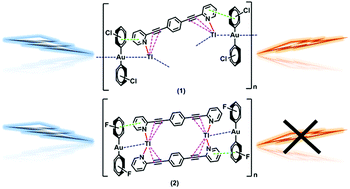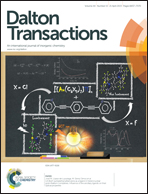1,4-Bis(2′-pyridylethynyl)benzene as a ligand in heteronuclear gold–thallium complexes. Influence of the ancillary ligands on their optical properties†‡
Abstract
The reaction of 1,4-bis(2′-pyridylethynyl)benzene (L) with [{Au(C6X5)2}Tl]n affords new heterometallic AuI/TlI complexes with different stoichiometries, structural arrangements and optical properties depending on the halogens present in the aryl group. The chlorinated derivative [{Au(C6Cl5)2}Tl(L)]n (1) displays polymeric chains built thanks to unsupported Au⋯Tl interactions and bridging bidentate ligands between adjacent chains, while in the fluorinated species [{Au(C6F5)2}2Tl2(L)2]n (2), also containing N-donor bridging ligands and Au⋯Tl contacts, polymerization occurs via Tl⋯Caryl non-bonding interactions between neighbouring molecules. The optical properties of 1 and 2 have been studied experimentally and theoretically, concluding that the luminescence of 1 in the solid state has its origin in the Au⋯Tl interactions, and that the Tl⋯Caryl interactions in 2 favour a non-radiative deactivation pathway that avoids luminescence. The strength of the non-bonding interactions present in 1 has also been theoretically studied at the HF and MP2 levels, revealing the metallophilic contact as the strongest one.


 Please wait while we load your content...
Please wait while we load your content...